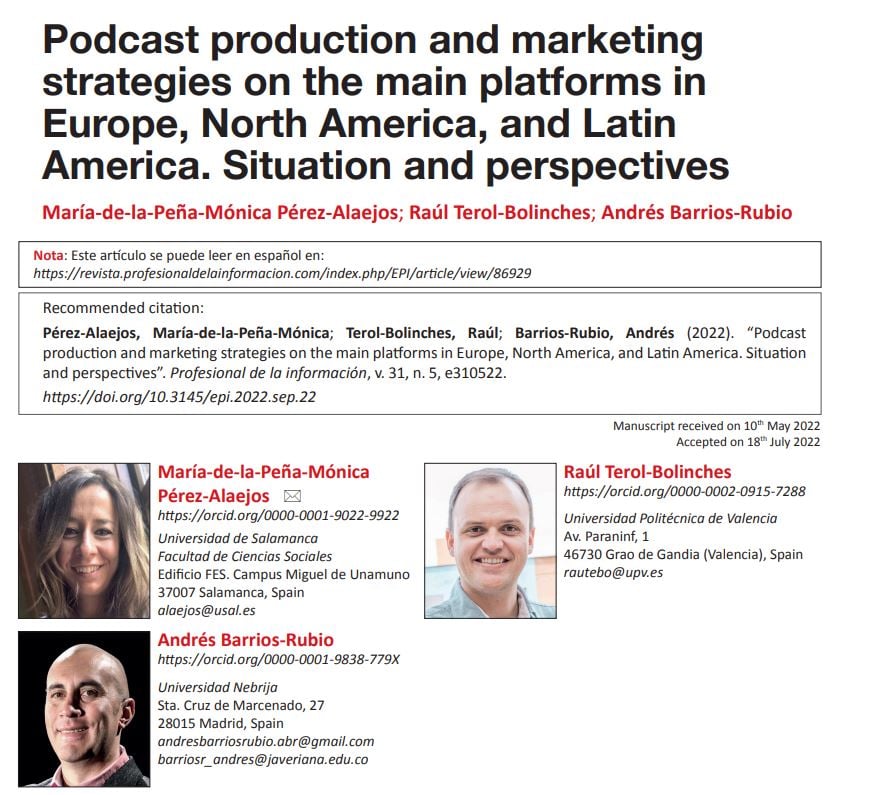
Podcast production and marketing strategies on the main platforms in Europe, North America, and Latin America. Situation and perspectives
On Sale
€15.00
€15.00
Abstract: Fifteen years after the term was coined, the podcast is now consolidated as a sound format with a specific identity within the digital media ecosystem. The practice of podcasting is none other than radio, but one encompassing diverse production on both expressive and thematic levels whose properties (mobility, narrative fragmentation, and the integration of multiple devices) and personalized consumption generate a very different listener attitude compared with traditional radio. After an initial period of independent amateurism strongly conditioned by the technologies available, the podcast has achieved significant global popular recognition, as well as an increasingly important professional dimension thanks to the emergence and spread of new distribution platforms (podcast networks) designed to serve as alternatives to the dominant feeds (such as Apple Podcasts, Google Podcasts, iVoox, and Spotify) that rely on different catalogs and business models. This investigation identifies, describes, and systematically orders the main management and marketing models for podcasts on these platforms on the basis of a comparative analysis of fourteen of them, two in each of the eight countries in Europe, North America, and Latin America where this format is most widespread: Acast (Sweden); Podimo(Denmark); Binge Audio and Majelan (France); Podimo Spain and Podium Podcast (Spain); PodcastOne and Luminary (USA); Convoy Network and Puentes (Mexico); Posta and Parque Podcast (Argentina); and Pia Podcast and Podway (Colombia). The study measures and compares the offerings of each of the studied platforms using different quantitative and qualitative variables (age, territorial reach, content categories, dominant genres, funding, and consumption). The objective is to start to draw up a global map of the main operators in the podcasting industry, and to identify the production trends and marketing strategies of a format with increasing impact and demand, destined to become the future heir of broadcast radio.
Resumen: Superados 15 años desde que se acuñase su término, el podcast se ha consolidado como un formato sonoro con identidad específica dentro del ecosistema de medios digitales. La práctica del podcasting no supone otra materialización de la radio, sino que engloba producciones de diversa índole tanto a nivel expresivo como temático cuyas propiedades - movilidad, fragmentación narrativa e integración multidispositivo - y consumo personalizado generan una actitud de escucha muy distinta a la del tradicional medio hertziano. Tras un primer período ligado al amateurismo independiente y muy condicionado por las tecnologías de acceso, el podcast ya ha alcanzado un significativo reconocimiento popular a escala global, así como una cada vez más relevante dimensión profesional gracias a la emergencia y proliferación de nuevas plataformas de distribución -Podcast Networks-, concebidas como alternativas a los agregadores dominantes -Apple Podcasts, Google Podcasts, iVoox, Spotify- y sostenidas sobre diferenciales catálogos y modelos de negocio. La presente investigación identifica, describe y sistematiza cuáles son los principales modelos de gestión y comercialización del podcast en estas plataformas a partir de un análisis comparativo sobre catorce de ellas, dos en cada uno de los ocho países con mayor penetración de este formato en Europa, Norteamérica y Latinoamérica: Acast (Suecia); Podimo (Dinamarca); Binge Audio y Majelan (Francia); Podimo España y Podium Podcast (España); PodcastOne y Luminary (EUA); Convoy Network y Puentes (México); Posta y Parque Podcast (Argentina); PIA Podcast y Podway (Colombia). El estudio mide y compara a través de variables cuantitativas y cualitativas (antigüedad, alcance territorial, categorías de contenido, géneros dominantes, financiación y consumo) las ofertas de cada plataforma. El objetivo es comenzar a delimitar un mapa a escala global de los principales operadores en la industria del podcasting, así como identificar las tendencias de producción y las estrategias de comercialización de un formato de creciente demanda e impacto llamado a convertirse con el tiempo en heredero de la radio de emisión lineal.
Resumen: Superados 15 años desde que se acuñase su término, el podcast se ha consolidado como un formato sonoro con identidad específica dentro del ecosistema de medios digitales. La práctica del podcasting no supone otra materialización de la radio, sino que engloba producciones de diversa índole tanto a nivel expresivo como temático cuyas propiedades - movilidad, fragmentación narrativa e integración multidispositivo - y consumo personalizado generan una actitud de escucha muy distinta a la del tradicional medio hertziano. Tras un primer período ligado al amateurismo independiente y muy condicionado por las tecnologías de acceso, el podcast ya ha alcanzado un significativo reconocimiento popular a escala global, así como una cada vez más relevante dimensión profesional gracias a la emergencia y proliferación de nuevas plataformas de distribución -Podcast Networks-, concebidas como alternativas a los agregadores dominantes -Apple Podcasts, Google Podcasts, iVoox, Spotify- y sostenidas sobre diferenciales catálogos y modelos de negocio. La presente investigación identifica, describe y sistematiza cuáles son los principales modelos de gestión y comercialización del podcast en estas plataformas a partir de un análisis comparativo sobre catorce de ellas, dos en cada uno de los ocho países con mayor penetración de este formato en Europa, Norteamérica y Latinoamérica: Acast (Suecia); Podimo (Dinamarca); Binge Audio y Majelan (Francia); Podimo España y Podium Podcast (España); PodcastOne y Luminary (EUA); Convoy Network y Puentes (México); Posta y Parque Podcast (Argentina); PIA Podcast y Podway (Colombia). El estudio mide y compara a través de variables cuantitativas y cualitativas (antigüedad, alcance territorial, categorías de contenido, géneros dominantes, financiación y consumo) las ofertas de cada plataforma. El objetivo es comenzar a delimitar un mapa a escala global de los principales operadores en la industria del podcasting, así como identificar las tendencias de producción y las estrategias de comercialización de un formato de creciente demanda e impacto llamado a convertirse con el tiempo en heredero de la radio de emisión lineal.
